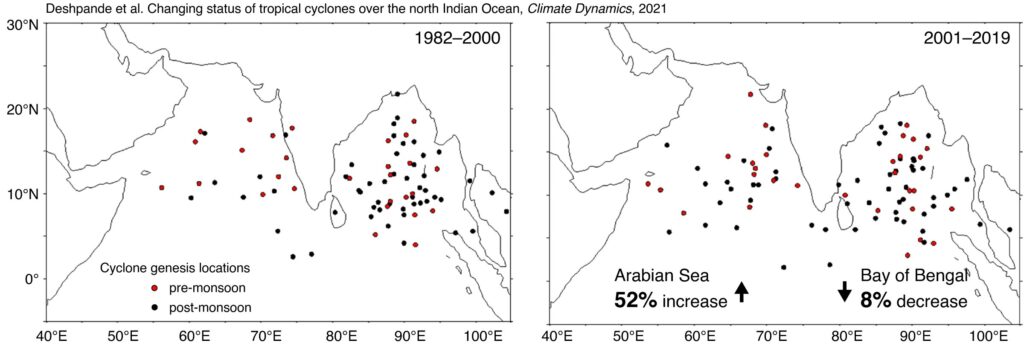The frequency, duration, and intensity of cyclones in the Arabian Sea have increased significantly whereas there has been a slight decrease in their frequency in the Bay of Bengal. Between 2001 and 2019, there was a 52 per cent increase in the frequency of cyclones in the Arabian Sea and a decrease of eight per cent in the Bay of Bengal.
These are the broad findings of a new research study, ‘Changing status of tropical cyclones over the north Indian Ocean’, published today, July 17, in Climate Dynamics, an international journal. The study has been conducted by the scientists of Pune-based Indian Institute of Tropical Meteorology (IITM), under the Union Ministry of Earth Sciences.
“Climatologically, the frequency of tropical cyclones (TCs) in the Bay of Bengal (BoB) is higher relative to that over the Arabian Sea (ARB). However, recent years exhibit a greater number of TCs forming in the ARB than in the BoB,” notes the study. But, “during the study period (1982–2019), a significant increasing trend in the intensity, frequency, and duration of cyclonic storms (CS) and very severe CS (VSCS) is observed over the ARB,” the study informs.

Cyclones in Arabian Sea getting more intense
Researchers have recorded an increment in the duration of cyclonic storms too. Between 1982 and 2000, the study found 80 per cent increment in cyclones and almost threefold increment (260 per cent) in ‘very severe cyclonic storms’ in Arabian Sea. No significant change in the duration of cyclones in the Bay of Bengal was observed.
The study notes that the increase in cyclone duration over the Arabian Sea is prominent during May, June, and October, and a decrease over the Bay is noted during November.
Further, the intensity of cyclones also has increased in the Arabian Sea, by about 20 per cent in post-monsoon season to 40 per cent in pre-monsoon, tweeted Roxy Koll, scientist with IITM and one of the authors of the study. He went on to inform that the translation speed of cyclones — the speed at which cyclone moves —has decreased in the Arabian Sea. This means that cyclones are now moving slowly.
2/ Frequency of Cyclones.
— Roxy Koll ⛈ (@RockSea) July 17, 2021
◉ 52% increase in the number of cyclones in the Arabian Sea. Very severe cyclones have increased by 150%.
◉ 8% decrease in the number of cyclones in the Bay of Bengal. pic.twitter.com/qTRG1X6Dkp
Global warming to be blamed
Scientists blame global warming and rising ocean temperature for the increase in frequency, duration and intensity of cyclones in Arabian Sea.
“The increase in the duration of TCs in the ARB is associated with an increase in mid-level relative humidity and column averaged (950-150 hPa) moist static energy, which is significantly correlated to an increase in sea surface temperatures and tropical cyclone heat potential in the basin,” reads the study.
“The increase in cyclone activity in the Arabian Sea is tightly linked to the rising ocean temperatures and increased availability of moisture under global warming,” tweeted Koll.


















